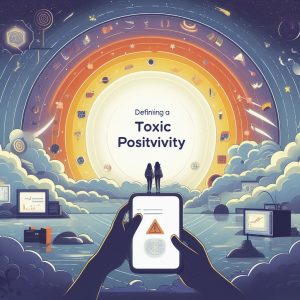In a world that often champions positivity, there exists a phenomenon known as toxic positivity, a trend that goes beyond encouraging a bright outlook to potentially harmful extremes. This article aims to unravel the layers of toxic positivity, exploring what it is, how to identify it, its potential impact on individuals, and the best approaches to handling this pervasive mindset.

Toxic Positivity
Defining Toxic Positivity
Toxic positivity is more than just an optimistic mindset; it’s an unrealistic emphasis on maintaining positivity at the expense of genuine emotions. It involves dismissing or invalidating authentic feelings, leading to a superficial understanding of emotional well-being. This section delves into the core characteristics of toxic positivity, highlighting the subtle ways it can manifest in daily life.
Identifying
Recognising toxic positivity is crucial for cultivating emotional authenticity. This section outlines key indicators, such as the habit of suppressing negative emotions, offering dismissive phrases like “just be positive,” and avoiding discussions about difficulties. By understanding these signs, individuals can start identifying toxic positivity in themselves and others.
The Impact of Toxic Positivity
The consequences of embracing toxic positivity can be profound, affecting mental health and relationships. This section explores how repressed emotions can lead to increased stress, anxiety, and a sense of isolation. It also discusses the impact on interpersonal connections, as genuine communication becomes compromised when one feels compelled to always present a positive facade.
Navigating
Handling the repercussions of toxic positivity involves acknowledging its presence and seeking healthier alternatives. This section provides practical strategies for individuals to navigate and counteract the effects of toxic positivity. Strategies include embracing vulnerability, fostering open communication, and cultivating self-compassion.
Cultivating Emotional Authenticity
A proactive approach to emotional well-being involves cultivating emotional authenticity. This section explores the importance of acknowledging a full range of emotions, both positive and negative, and the role of self-reflection in fostering genuine emotional experiences. It emphasises the significance of creating a supportive environment that encourages authenticity.
Encouraging a Balanced Mindset
Promoting a balanced mindset involves embracing both positive and negative emotions without judgement. This section discusses the value of realistic optimism, which acknowledges challenges while maintaining a hopeful perspective. It encourages individuals to reframe their mindset to appreciate the complexity of emotions and life experiences.
Embracing Emotional Wholeness
Toxic positivity is a pervasive mindset that can hinder genuine emotional experiences and negatively impact well-being. By understanding, identifying, and navigating this phenomenon, individuals can foster emotional authenticity, creating a foundation for healthier relationships and improved mental health. Embracing a balanced mindset that acknowledges the spectrum of emotions is the key to achieving emotional wholeness in a world that often pressures us to only focus on the positive.
